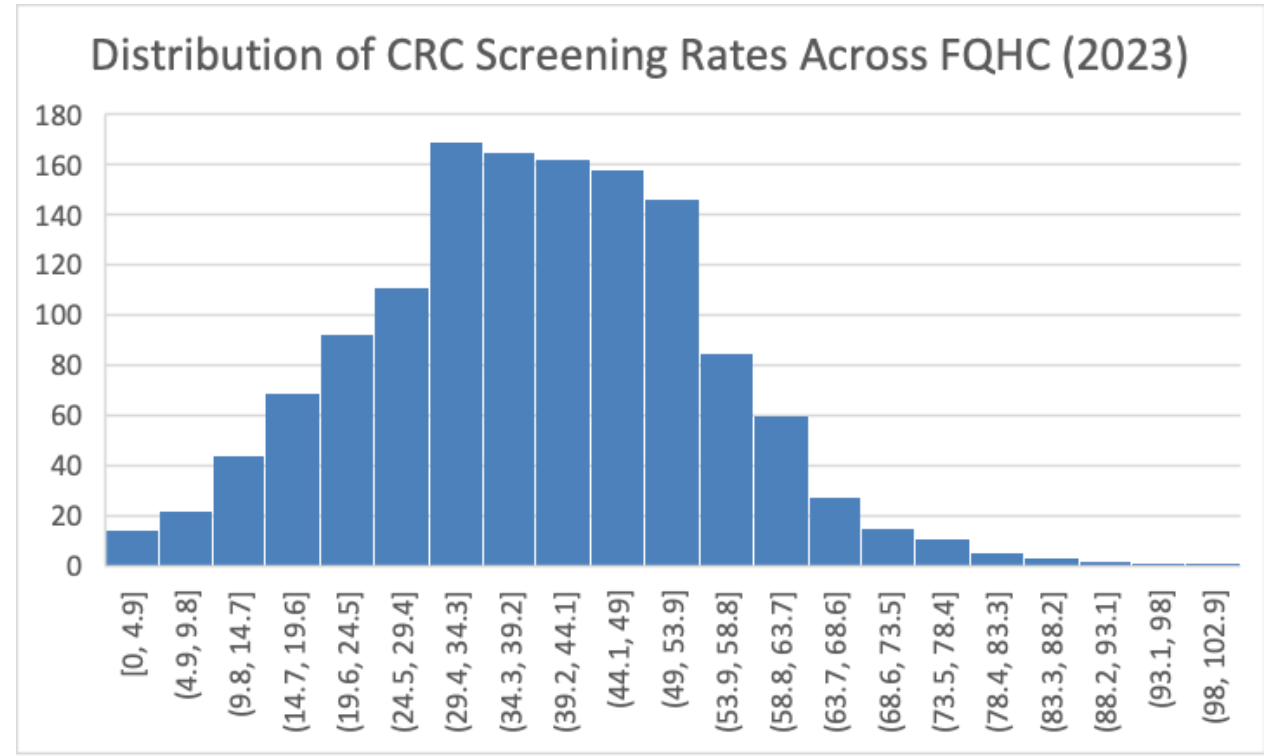Sunday Poster Session
Category: Colorectal Cancer Prevention
P0484 - Colorectal Cancer Screening Performance Across Federally Qualified Health Centers: A Cross-Sectional Analysis of 2023 HRSA UDS Data
Sunday, October 26, 2025
3:30 PM - 7:00 PM PDT
Location: Exhibit Hall

Urmimala Chaudhuri, DO
Wright State University
Centerville, OH
Presenting Author(s)
Urmimala Chaudhuri, DO1, Kamil Salam, DO2
1Wright State University, Centerville, OH; 2Wright State University Boonshoft School of Medicine, Dayton, OH
Introduction: Federally Qualified Health Centers (FQHC) serve underserved populations including low-income or underinsured individuals, by providing preventive services such as colorectal cancer (CRC) screening. CRC screening rates declined during the COVID-19 pandemic. The Healthy People 2030 goal targets more than 74.4% screening among adults aged 45-75. This study aimed to assess national CRC screening performance post-pandemic using 2023 data.
Methods: We conducted a cross-sectional analysis of publicly available data from the 2023 Uniform Data System (UDS) reported by FQHCs to the Health Resources and Services Administration (HRSA). We evaluated clinic-level CRC screening rates, defined as the percentage of adults aged 46-75 who received appropriate screening. Descriptive statistics included mean, median, interquartile range (IQR), minimum, and maximum screening rates that were calculated and stratified by U.S. Census region and urban vs rural designation. We compared the performance of FQHCs to the Healthy People 2030 target of 74.4%. All analysis was conducted using Microsoft Excel.
Results: There were a total of 1,362 FQHCs that reported CRC screening data to the UDS in 2023. Of the 8,045,595 eligible patients aged 46-75, there were a total of 3,306,818 patients who were screened. The mean clinic-level screening rate was 39% (median 39.1%, IQR 28.6-49.5%). There were only 21 centers who met or exceeded the Healthy People 2030 target. When stratified by region and rural/urban, rural FQHCs in the Northeast had the highest mean screening rate at 52.2%, while urban centers in the Midwest had the lowest (36.1%). Screening rates varied widely with some centers reporting as low as 0-2% and others achieving rates above 90%.
Discussion: Almost all FQHCs did not meet the national CRC screening benchmark in 2023. Only 21 centers (1.5%) met or exceeded the Healthy People 2030 target of 74.4%. Even among the top-performing 10% of clinics, the average screening rate was just 58%, highlighting a significant shortfall. With fewer than five years remaining to achieve national CRC screening goals, these findings underscore the urgency of implementing targeted, equity-focused interventions in underperforming regions such as the urban Midwest.

Figure: Histogram showing the distribution of colorectal cancer (CRC) screening rates across Federally Qualified Health Centers (FQHCs) in 2023.
Disclosures:
Urmimala Chaudhuri indicated no relevant financial relationships.
Kamil Salam indicated no relevant financial relationships.
Urmimala Chaudhuri, DO1, Kamil Salam, DO2. P0484 - Colorectal Cancer Screening Performance Across Federally Qualified Health Centers: A Cross-Sectional Analysis of 2023 HRSA UDS Data, ACG 2025 Annual Scientific Meeting Abstracts. Phoenix, AZ: American College of Gastroenterology.
1Wright State University, Centerville, OH; 2Wright State University Boonshoft School of Medicine, Dayton, OH
Introduction: Federally Qualified Health Centers (FQHC) serve underserved populations including low-income or underinsured individuals, by providing preventive services such as colorectal cancer (CRC) screening. CRC screening rates declined during the COVID-19 pandemic. The Healthy People 2030 goal targets more than 74.4% screening among adults aged 45-75. This study aimed to assess national CRC screening performance post-pandemic using 2023 data.
Methods: We conducted a cross-sectional analysis of publicly available data from the 2023 Uniform Data System (UDS) reported by FQHCs to the Health Resources and Services Administration (HRSA). We evaluated clinic-level CRC screening rates, defined as the percentage of adults aged 46-75 who received appropriate screening. Descriptive statistics included mean, median, interquartile range (IQR), minimum, and maximum screening rates that were calculated and stratified by U.S. Census region and urban vs rural designation. We compared the performance of FQHCs to the Healthy People 2030 target of 74.4%. All analysis was conducted using Microsoft Excel.
Results: There were a total of 1,362 FQHCs that reported CRC screening data to the UDS in 2023. Of the 8,045,595 eligible patients aged 46-75, there were a total of 3,306,818 patients who were screened. The mean clinic-level screening rate was 39% (median 39.1%, IQR 28.6-49.5%). There were only 21 centers who met or exceeded the Healthy People 2030 target. When stratified by region and rural/urban, rural FQHCs in the Northeast had the highest mean screening rate at 52.2%, while urban centers in the Midwest had the lowest (36.1%). Screening rates varied widely with some centers reporting as low as 0-2% and others achieving rates above 90%.
Discussion: Almost all FQHCs did not meet the national CRC screening benchmark in 2023. Only 21 centers (1.5%) met or exceeded the Healthy People 2030 target of 74.4%. Even among the top-performing 10% of clinics, the average screening rate was just 58%, highlighting a significant shortfall. With fewer than five years remaining to achieve national CRC screening goals, these findings underscore the urgency of implementing targeted, equity-focused interventions in underperforming regions such as the urban Midwest.

Figure: Histogram showing the distribution of colorectal cancer (CRC) screening rates across Federally Qualified Health Centers (FQHCs) in 2023.
Disclosures:
Urmimala Chaudhuri indicated no relevant financial relationships.
Kamil Salam indicated no relevant financial relationships.
Urmimala Chaudhuri, DO1, Kamil Salam, DO2. P0484 - Colorectal Cancer Screening Performance Across Federally Qualified Health Centers: A Cross-Sectional Analysis of 2023 HRSA UDS Data, ACG 2025 Annual Scientific Meeting Abstracts. Phoenix, AZ: American College of Gastroenterology.
